#children's nursery rhymes
Text
London Bridge is Falling Down!
Today I thought it would be fun to talk about children's nursery rhymes. Since we've had language, and maybe even before, children have probably been making up rhymes to measure out beats as they play a game of repetition. Jump rope, circle dances, skipping, hand clapping. How many silver buttons does Miss Merry Mac have down her back? There's something almost sacredly human about the desire to put music to our play, to sift through words to find the ones that go well together and make up stories with them.
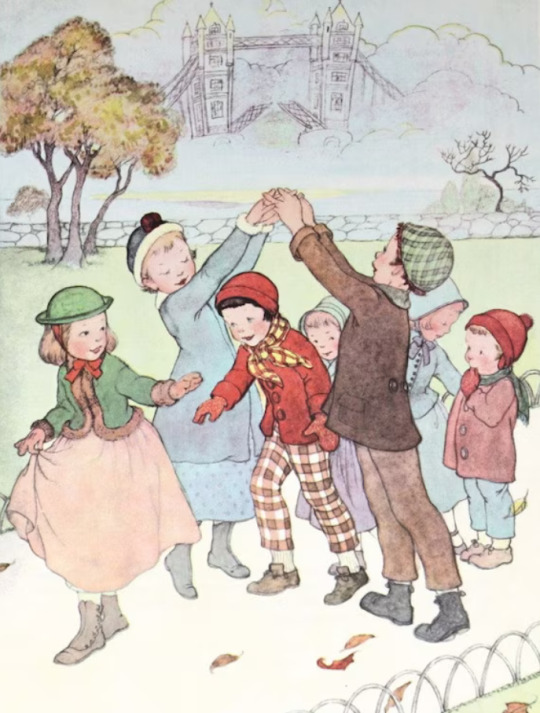
And the thing about children is that they often repeat, in part and only partial understanding, what they hear going on in the adult world around them.
London Bridge is falling down
falling down
falling down
Maybe you played this one as a child yourself. Two children hold hands, arms raised and everyone else must pass between them and under their arms while the song is chanted. At the last moment:
Take the keys and lock her up
lock her up
lock her up
take the keys and lock her up
my fair lady.
the two children forming the 'bridge' with their raised hands drop their arms and catch the child trying to go through. Much laughing and half struggling ensues and then the captured child either sits the game out or takes over for one of the 'bridges' and the song begins again.
London Bridge is falling down.
Perhaps we're all too well trained by horror movies but there can be a whisper of something more haunting in the simple game if you want there to be. A song about a falling bridge and a captured lady, trapped inside the supports of the human girders. Was there something darker once? Something children knew about the adult world that they filtered down into their songs and playtime, absorbing it as children will do into half truths and make-believe, until all that was left of it was a children's rhyme about captive ladies and falling bridges?
Tell me if you've heard this one.
Once upon a time, far back in our grey history but not as far back as we'd like it to be, there was a belief that human buildings of importance needed more than just human ingenuity to keep them standing against the wear and tear of use and time. Against the things that fluttered through our shadows and ran in our dark streets at the edges of our eyesight. Folklore said that the first person buried in a new churchyard didn't get into heaven. Instead, their souls had to guard the now sacred grounds until the final Trumpet, when the world ended and they would be released from their eternal vigilance. Oftentimes, a dog would be buried in the churchyard first, a canine stand-in guardian, protecting the human souls and seeing them on their way, patient in its duty until the Last Day.
According to some legends, graveyards weren't the only human creations that needed a human soul to stand guard over them.
Immurement is the practice of walling someone up inside a building while they are still alive (Cask of Amontillado style). It was used as a form of punishment for a large swath of cultures and many a folktale sprung up about it even in places where there wasn't any physical proof. Thieves, treacherous daughter, spies, star-crossed lovers and political opponents all met their ends walled up in foundations and tunnels under palaces in the stories.
So it shouldn't surprise you if I tell you that the children's skipping rhyme 'London Bridge' is rooted in the same dark practice. Take the keys and lock up the fair lady so that London Bridge will never fall...
Except - that's not really true.
It makes a good story though.
Let's start with the older version of the poem. Now its a rhyme about a bridge that's in need of repair and the higher and higher quality items that are used to build it better until we're using silver and gold to build our bridge (and hiring someone to guard all that silver and gold for the low, low price of a pipe (though one wonders what was in the pipe if it would keep him up all night?)) Also, London Bridge isn't the only bridge with a children's song about it falling down. Before London Bridge was even built there are records of the same kind of song in France, Germany, Italy and Denmark. Korea, far from London Bridge, has a similar song and game as well.
Children singing about the crumpling infrastructure apparently isn't anything new.
Don't give up yet though. London Bridge might have triggered children into singing about its dark shadow beyond the childhood need to see things fall apart around them.
In 1014 (or thereabouts) London Bridge was supposedly badly damaged in a Viking raid (at least that's what some of the texts from that time claimed). There were also several fires in the 1600s, including the Great Fire of 1666 (its gonna be a hot time in the old town tonight) which badly damaged the bridge.
London Bridge had a lot of reasons to fall down and in 1831 it finally did - though it was less a 'fall 'and more a demolition as it was considered cheaper to simply build a new one instead of repair the old.
As for the 'fair lady'? There are several theories about her, from a rich patron to the Virgin Mary. For my money? It's the River Lea, which is a tributary of the Thames and could easily be seen as being 'locked up' when the bridge closed over it.
So was it a ghost story for nothing?
Not - just yet. In 2007, just in time for Halloween, the BBC News reported excavations under London Bridge were turning up bones - and hauntings. There might not be bodies walled into the foundations to keep the bridge standing - but London Bridge saw its fair share of deaths, including the heads of criminals and those out of favor with the crown, that got stuck on spikes along its walls. The children's rhyme might not be as spooky as hoped - but London Bridge itself has no intention of slacking.

#london bridge#nursery rhymes#children's nursery rhymes#nursery rhyme#superstition#spooky#ghosts#horror story#history#folklore#scary story#london bridge is falling down#crumbling infrastructure#lady lee#lady lea#lea river
26 notes
·
View notes
Text
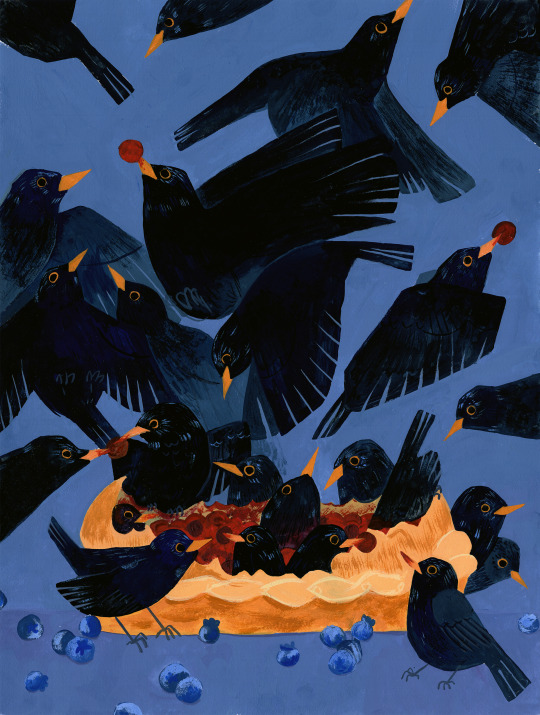
🐦⬛🫐 🥧 🐦⬛ ✨ prompt 12 // pie & feast // gouache on hot press paper
#my art#four & twenty blackbirds reject being baked in a pie#feast on it instead#gouache#illustration#painting#cottagecore#art#artists on tumblr#picture book illustration#artober#13 days of art#nursery rhyme#children's books#picture book#birds#blackbird#blueberries#bird art
1K notes
·
View notes
Text

Jumy-M
Kagome Kagome / かごめかごめ #2
かごめかごめ
籠の中の鳥は いついつ出やる
夜明けの晩に 鶴と亀が滑った
後ろの正面だあれ?
The bird in the cage
When will it come out
In the night of dawn
The crane and turtle slipped
Who is behind you now?
Kagome Kagome #1
#かごめかごめ#童謡#わらべ歌#nursery rhyme#Japanese children's song#japan#イメージ#kotoba#kagome kagome#人形#doll#jumym#photographers on tumblr
131 notes
·
View notes
Text

#richard scarry#the busy world of richard scarry#books#kids books#vintage#children's books#reading#cats#nursery rhymes#kidcore#nostalgia#nostalgic#retro#childhood#food#illustration#book cover#kittens#pie#nostalgiacore#1980s#80s kid#90s kid#1990s
386 notes
·
View notes
Text

#nursery rhymes#existentialism#existence#life#children's literature#metaphysics#philosophy#reading#wronghands#webcomic#john atkinson#humor#lifestyle
64 notes
·
View notes
Text

The cow jumped over the moon. R. Caldecott's second collection of pictures and songs. 1895.
Internet Archive
#cow jumped over the moon#nursery rhyme#randolph caldecott#children's book illustration#nursery rhymes#nemfrog#1895#19th century
336 notes
·
View notes
Text

Hatsuyama Shigeru (1897-1973), ''Nursery Rhyme Songs'' (童謡小曲集), 1929
Source
I've really become a fond of Hatsuyama’s illustrations since coming across his work. There's something pleasing in his use of line that I would describe as playfully skillful. It has the feel of a child's drawing coupled to an obvious sense of developed artistic craft. I dig it.
I went digging around for more information about Hatsuyama and came across the following brief description of the man:
"Since first attracting attention at the age of 22 for his work in the fairy tale magazine Otogi no Sekai (The World of Fairy Tales), Shigeru Hatsuyama (1897–1973) was an essential artist in the world of “Doga” (art for children) for more than 50 years spanning Japan’s Taisho to Showa periods. He skillfully blended the decorative beauty of the Edo period, which he had been exposed to since childhood, with modern Western sensibility to create works characterized by free expression in accordance with his aesthetic sense. Even now, some 50 years after his death, Hatsuyama’s work continues to appear new, conveying a sense that is brimming with freshness. From the latter half of the 1930s, he also produced many self-engraved woodblock prints, which also opened a window onto the original world of his artwork." (Source) (with more info here)
74 notes
·
View notes
Text

27 notes
·
View notes
Text

#🥹🥹🥹#how cute#cute#cats#kitten#kittens#cute kitty#cutekitten#cute cats#nursery rhymes#children's books#children's stories#artwork#art#cute art#cute kitties#sweet#pie#blackberry#blackberries#pies#cutie pie#cuties#aesthetic vintage#vintage#vintage aesthetic#vintage art
23 notes
·
View notes
Text
Gripped with ideas but….. the panelling………….

#banging my head against the wall#Im probably thinking abt it too hard but ive never given much thought abt executing my ideas till now#usually I just get out as many things as I can in messy sketches but because this one has Structure and Unspoken Thoughts that need to be#conveyed properly using mood and emotion than words I actually need to be a little deliberate abt how I go about expressing it#i found some tips for composition and going thru my comics for reference and trying to line it up with what I have in mind#but the mood im going for is more of a quiet looming dread.. like. yknow when a bunch of bad memories start rushing out while your mind#is in the present. im thinking of having paralleling panels to kind of build on symmetry or making comparisons to a past experience#i was thinking of having another set of overlapping panels showing the characters reaction to those thoughts in real time like a pencil#slipping out of their hand and falling to the floor but I don’t wanna clutter the page too much so maybe not#I don’t have much experience writing comics I just like to read em.. I’m sure it’ll be at least decent for a first attempt. hopefully#that way I can build up confidence for my other zelda comic ideas heh#without saying too much….. the idea I have in mind is about fort hateno and children’s nursery rhymes ;)#yapping
21 notes
·
View notes
Text
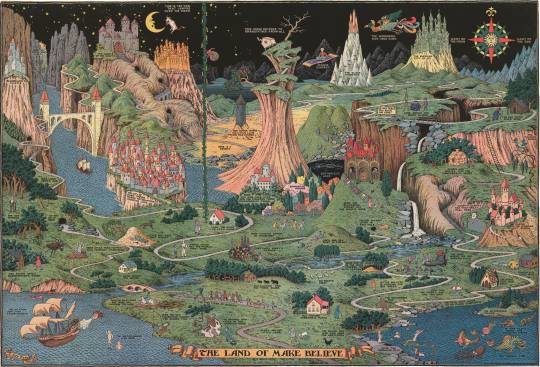
I was recently reminded of the existence of this artwork, so I'll make a quick post about it. I had a very large version of the picture allowing t scrutinize little details - but unfortunately the size limit of Tumblr shrunk the picture.
This is the map known as "The Land of Make Believe", the most famous work of Jaro Hess - a collection of more than sixty references to various fairy tales, nursery rhymes, pieces of children literature and European legends, collected together in the shape of one fantastical and magical land. It was published in the early 1930s.
I will leave under the cut a complete list of all the places described and named on this map (a bit more than sixty in total):
Here the North Wind lives
Bluebeard's Castle
Here lives Peter Pan
Rip Van Winkle
Do not go in here
Here Little Miss Muffett was terribly frightened
Red Riding Hood's Grandmother's house
Jack Sprat - His house
The dilatory ship that never comes in
The Water Babies live here
Here the old man caught the golden fish
Dapple Gray Poney she rode him through the mire
Little Boy Blue fast asleep
The city of many towers where the beautiful princess lives
The castle of the giants
This is the cow that jumped over the moon
The city of brass
Jack the giant killer's house
Simple Simon met the Pieman here
Goldilocks and the Three Bears
The Pied Piper of Hamelin
The Crooked Man lives in his Crooked House
Mary and her Little Lamb
The black hen who laid eggs for gentlemen
Old Mother Hubbard's place
Bo-Peep's sheep
Contrary Mary's garden
Jack and Jill went up this hill
Here fairies dance in the moonlight
Here the Old King Col lives and the fiddlers three occasionally fiddle
Enchanted woods
Bottomless lake
Here is a desert
High tower where the little lame prince was locked
This house belongs to Grandfather-know-all
Magic carpet
The glass mountain
The wonderful Moo-Moo bird
The Emerald City of Oz
Long, Broad and Swift Glance
Do not walk near the edge!
Hansel and Gretel find the gingerbread house
Here the black bird picked off the maid's nose
Peter Rabbit lives in this hole
Here are the Babes in the Woods, covered in leaves
The shoe here the old woman lives
Little Bo Peep is looking for her sheep
The Wandering Jew
Tom-Tom the piper's son ran this way
Here the mermaids play
The Squall Fish
In this place there are peculiar fishes
The mysterious island
The path that leaves to no place eventually
The house that Jack built
Cinderella lives here
The castle where the Sleeping Beauty sleeps
Humpty Dumpty had that great fall here
The talking bird
The old witch lives here
West of the moon
East of the sun
#the land of make believe#fantasy map#fairytale map#art#jaro hess#fairytale crossover#nursery rhymes#fairytales#children literature#fairytale land
73 notes
·
View notes
Text
Peter Peter Pumpkin Eater
A while ago we did a bit of a deep dive into the nursery rhyme London Bridge and found, to either our relief or our disappointment, that it wasn't nearly as dark as the rumors would have it be. The origin of the chant turned out to be rather benign when you consider it talked about locking women up and throwing away the key. If we can't count on good old crumbling infrastructure and bondage to give dark notes to our childhood rhymes, what can we count on?
Apparently, the answer is: pumpkins.
Let's take a look at Peter the Pumpkin Eater.
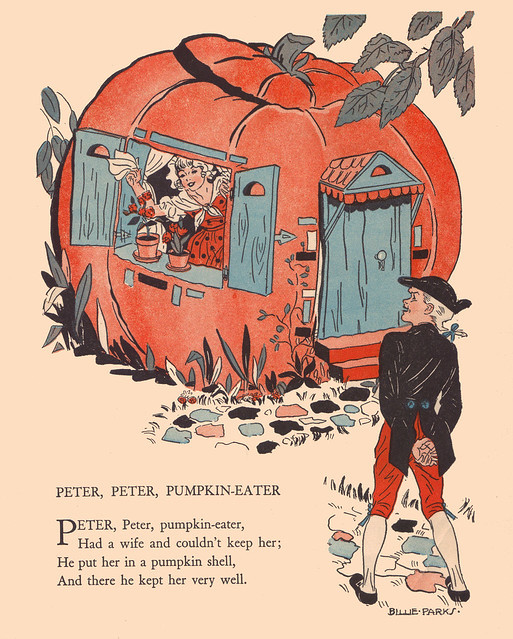
Most of us know this one.
Or rather, I should state that most of us know the first half of this one. But did you know it has a second verse?
It goes like this:
Peter, Peter, pumpkin-eater,
Had a wife and couldn't keep her;
So he put her in a pumpkin shell,
And there he kept her very well.
Peter, Peter, pumpkin-eater,
Had another and didn't love her;
Peter learned to read and spell,
And then he loved her very well.
While literacy is very important, apparently the moral of the poem no less, most of us have never heard of that second verse. Or that Peter apparently had a second wife. Still, having a second wife is hardly uncommon and, for a great deal of history until not even that long ago, given how often women died in childbirth, it was alarmingly normal for a man to become a widower and remarry multiple times. So the rhyme basically goes - Peter kept his first wife in a pumpkin and then got a second he didn't love until he was educated properly. Which -
that's a weird basis for a children's chant isn't it? I mean, yes, the point is the words have to keep a beat, not necessarily make sense and living inside of a pumpkin house is, let's face it, pretty much a dream for most kids, and some adults, so you can see the appeal. How did it all get started in the first place though? And, as weird as falling in love once you can spell is for the second verse, isn't the first verse about not being able to keep a wife until you build her a pumpkin house even weirder?
Weirder - and about to get a lot darker too.
Let me dig up another nursery rhyme from about that time for you. It goes like this:
Eeper Weeper, chimney sweeper,
Had a wife but couldn't keep her.
Had another, didn't love her,
Up the chimney he did shove her.
There's a name change going on but we can all recognize the chant. And, again, we've got two wives. One that 'couldn't be kept' and one that, unfortunately, got 'kept' permanently. Suddenly that 'pumpkin shell' isn't sounding so fairy tale romantic.
I mentioned in the London Bridge post that children have the ability to soak up what's going on in the world around them and translate it into their own language, something for other children to resonate with, absorbing information as they pass it along. And repetitive skipping games are one of the oldest patterns known to children the world over. Take one down, pass it around. Somebody takes the daily news or local gossip or creepy house down the street and patches together words to make out a beat, telling a story that will titillate their schoolmates as well as help them keep count in their game. Because of the beat and the easy nature of the words, its a simple matter for other children to memorize the rhyme and pass it on. Humanity creates their world out of words and children are no different. Times goes on and maybe an adult steps in and changes the words to something more 'kid-friendly' and the next thing you know, you're building houses out of pumpkin shells.
Is that what happened here or am I just being melodramatic and creepy for the sake of a good story?
Well.
Both of the above skipping rhymes? They probably come from a still older one.
Peter, my neeper,
Had a wife,
And he couldna' keep her,
He pat her i' the wa',
And lat a' the mice eat her.
Fairy tales often have dark roots. It turns out nursery rhymes aren't necessarily that far behind. Was there a historic 'Peter', whose wife wanted to leave him, who killed her instead and hid her body?
Unfortunately the question is more likely - which 'Peter' got the children using his story to keep the beat in their skipping game?

#nursery rhymes#peter peter pumpkin eater#mother goose#vintage#dark nursery rhymes#nursery rhyme origins#children's nursery rhymes#spooky#horror story#history#folklore#scary story
15 notes
·
View notes
Text

Attack of the Man Eating Plums!
#nursery rhymes#illustration#Vintage illustration#childrens illustration#children's illustration#children's book#funny#humor#humour
26 notes
·
View notes
Text
Muppet Fact #913
In the Disney Junior Music: Nursery Rhymes shorts, animated versions of the Muppet Babies appear in twelve of the songs. These being: "Twinkle Twinkle Little Star," "The Wheels on the Bus," "If You're Happy and You Know It," "One, Two, Buckle My Shoe," "The Alphabet Song," "One Potato, Two Potato," "Froggy Went A-Courtin'," "This Little Piggy," "Where is Thumbkin," "Jingle Bells," "Twelve Days of Christmas," and "Hickory Dickory Dock."

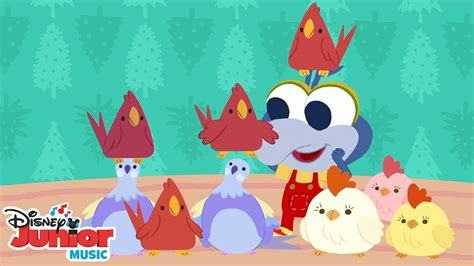
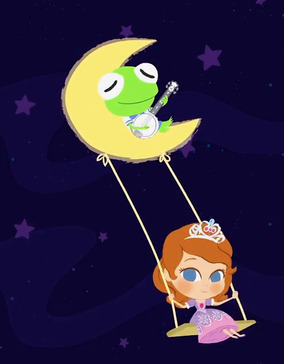
Sources:
"Muppet Babies Nursery Rhymes! | 🎼 Disney Junior Music Nursery Rhymes | Disney Junior." Disney Junior. YouTube. May 29, 2018.
"One Potato, Two Potato 🥔 | 🎶 Disney Junior Music Nursery Rhymes | Disney Junior." Disney Junior. YouTube. July 17, 2018.
"Froggy Went A-Courtin' 🐸 ❤️ 🐷| 🎶 Disney Junior Music Nursery Rhymes | Disney Junior." Disney Junior. YouTube. July 30, 2018.
"This Little Piggy 🐷 | 🎶 Disney Junior Music Nursery Rhymes | Disney Junior." Disney Junior. YouTube. August 27, 2018.
"Where is Thumbkin? | 🎶 🎼 Disney Junior Music Nursery Rhymes | Disney Junior." Disney Junior. YouTube. September 3, 2018.
"Jingle Bells 🔔 | 🎶 Disney Junior Music Nursery Rhymes | Disney Junior." Disney Junior. YouTube. November 5, 2018.
"12 Days of Christmas 🎄| 🎶 Disney Junior Music Nursery Rhymes | Disney Junior." Disney Junior. YouTube. November 10, 2018.
"Hickory Dickory Dock | 🎶 Disney Junior Music Nursery Rhymes | Disney Junior." Disney Junior. YouTube. January 21, 2019.
#muppet facts oc#jim henson#the muppets#muppets#muppet facts#fun facts#muppet babies#childrens tv#Disney Junior#youtube link#nursery rhymes
35 notes
·
View notes
Text
The world record for most children born to one mother is 69, with 67 surviving infancy.
There was an old lady who lived in a shoe. She had so many children, she didn’t know what to do. She gave them some broth, without any bread ; And whipped them all soundly and put them to bed.
#not that this nursery rhyme is built on logic lmao#but what do you think?#eah#ever after high#descendants#nursery rhyme#there was an old lady#there was an old lady who lived in a shoe#she had so many children she didn’t know what to do#She gave them some broth without any bread;#and whipped them all soundly and put them to bed#woman who bore the most children#woman with the most kids#big family#big families#multiple kid family#fairytales#fairytale#huge family#woman who lives in a shoe#nursery rhyme poll#poll#polls#woman with the most kids record#most kids to one mother#most kids to one mother record#lady who lives in a shoe#there was an old lady who lived in a shoe ; she had so many children she didn’t know what to do#she gave them some broth without any bread ; and whipped them all soundly and put them to bed#nursery rhyme debate
10 notes
·
View notes
